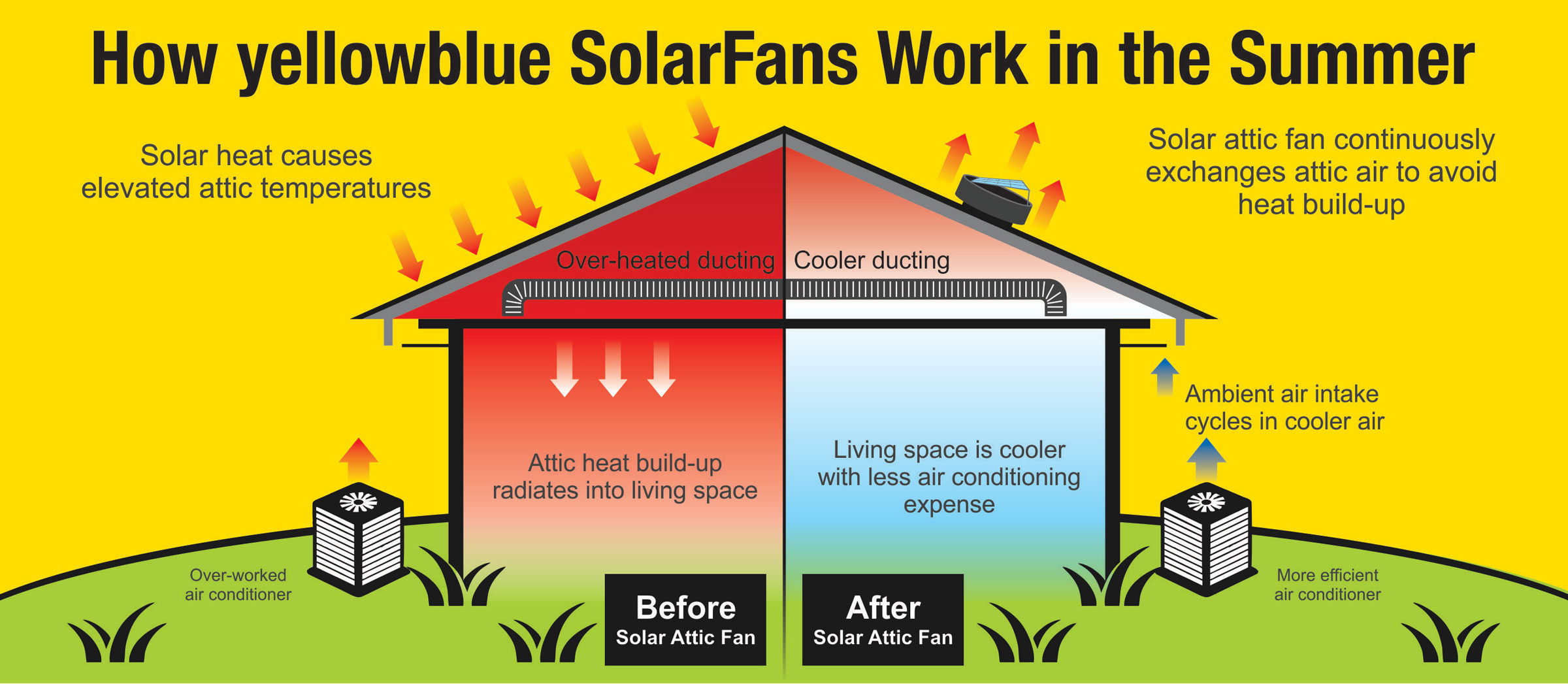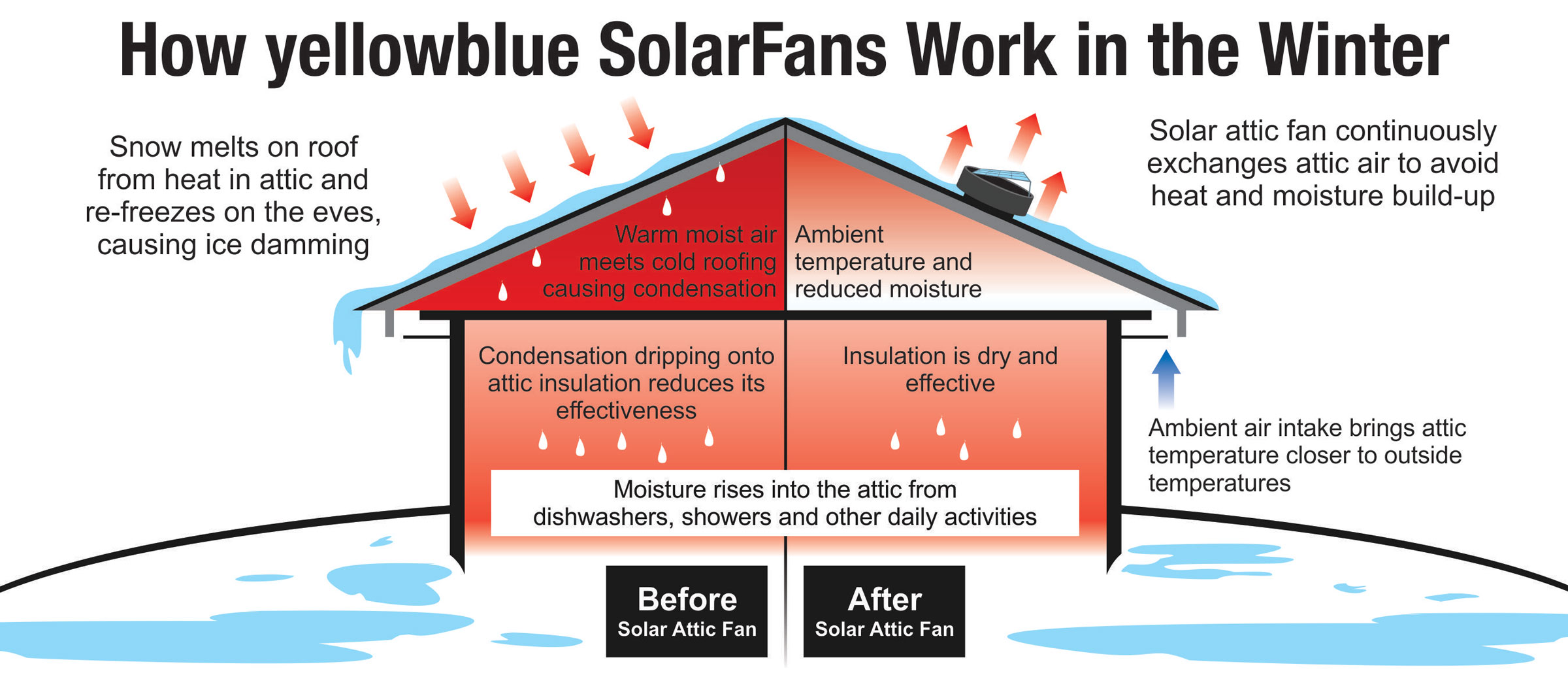From 500 feet in the air most roofs look the same. The average roof is pitched for better durability and covered with asphalt shingles to provide a protective barrier from the elements. Yet what lies beneath varies more than how many bathrooms or bedrooms you have.
Whether you live in a modest single-family home or in a three-story mansion with a view, chances are you have attic space somewhere within your home. Whether you use your attic as extra living space or to store family antiques and keepsakes, ensuring it is properly ventilated benefits the energy efficiency of your home throughout the seasons.
Understand the basics
In the heat of summer, proper attic ventilation helps keep the space cool, resulting in lower electric bills. Research shows roof ventilation products help significantly reduce attic temperatures.
The year-round benefits of proper roof ventilation systems abound, including helping to protect the structure and materials of your home, aid in reducing energy costs and ultimately make your home a more comfortable place to live.
 Attic ventilation protects your investment
Attic ventilation protects your investment
Making sure your home is equipped with a sound attic ventilation system is a proactive move on the part of any homeowner.
The results of a 2010 case study by the United States Department of Energy found the installation of two solar powered attic ventilator fans in a single-family home reduced peak summer attic temperatures by more than 20 degrees.
Taking into consideration measurements of attic air temperature, meteorological condition and space cooling electric power, the study also pointed to the home having adequate insulation and sealing prior to installation of the fans.
In cooler climates where snow falls frequently and temperatures plummet in the winter, many of us turn up the heat to stay cozy and warm. What that means for our attic space remains an out-of-sight, out-of-mind concept for many despite it being a crucial component to maintaining an energy efficient living space.
Yet all of that moisture from below needs to go somewhere, oftentimes creeping through the ceiling and into the attic. The contrast in temperature harbors a multitude of problems, as documented and thoroughly explained by the Asphalt Roofing Manufacturer’s Association:
- Condensation forms on cold surfaces, including the rafters, nails and other structural components of the roof, causing potential damage to the integrity of the structure as well as rotting, damp insulation and other problems. Ensuring air flows efficiently through the area helps keep condensation from forming, ultimately helping to protect the structural integrity of the roof as a whole.
- All of the moisture in the area also lends itself to the growth of mold and mildew. When moist or conditioned air is allowed to become stagnant, it becomes a breeding ground for harmful bacteria, which can be avoided when air is circulating throughout the attic space.
- Ice dams are more likely to form and hang over soffits, causing undue pressure on the roof and soffits, but also a danger to visitors of your home. When an attic is properly ventilated, ice dams are less likely to form, which can help extend the life of your roof.
Attic ventilation reduces energy consumption
Steady airflow through the attic helps combat a myriad of problems. On the flip side of the coin, ventilation in an attic during the summer months can have a profound impact on your energy use. Heat that bears down on the roof multiplies with the sun’s powerful rays and will penetrate into your home to some degree despite what efforts you take to prevent it.
It’s no surprise the heat doesn’t stop there. It moves through into the attic and penetrates the ceiling floor in a desperate effort to seep into your living quarters. While there may not be a way to stop this from happening entirely, there are steps you can take to help reduce the effect of both the bitter cold and harsh warmth on your electricity bill.

Owners of a single-family home where air temperatures in the attic reached 130 degrees on average during the hottest days of the year saw temperatures decrease by as much as 20 degrees in their attic space after taking steps to properly ventilate. For them, those steps involved installing solar powered roof vents in addition to extra steps to insulate and seal the space, bringing to life the following concepts:
- Reduction in heat can make a difference in what your family pays to keep your home cool during summer.
- Keeping your home cooler during the summer months, you help to reduce the carbon footprint of your home.
Yet the decision to be smart about attic ventilation is a proactive one during the frigid winter months as well.

-
Heat damage is just as much a reality as the deterioration that is possible during the colder months of the year. It can cause unsightly issues that devalue your home, but even more importantly, the problems can all be prevented if proper steps are taken to do so. Among the issues are:
- A deteriorated roof that shows signs of premature aging
- Dangerous ice dams that could injure you, your family or visitors to your home
- Damaged soffits from development of ice dams
- Mold and mildew buildup in your attic
- Damaged personal items, like keepsakes or antiques
- Cracking, aging and deterioration of exposed (and hidden) structural roof elements
Attic ventilation adds comfort in line with industry standards
Attic ventilation is essential for a healthy roof and ultimately a healthy home. Regulating the air in your attic is a smart move. It makes your home that much more your own (and therein protecting your investment) and complies with federal and international standards in the matter.
The International Code Council, the United States Department of Housing and Urban Development and the American Society of Heating, Refrigerating and Air-Conditioning Engineers (ASHRAE) follow a code of standards for ventilation. Among the specifications in the code is the requirement of a minimum of one-square-foot of net-free ventilation area for every 150 square feet of attic floor space.
The United States Department of Energy reports that ASHRAE “has determined that a home’s living area should be ventilated at a cubic feet per minute (CFM) rate determined by adding 3 percent of the conditioned space floor area to 7.5 times the number of bedrooms plus one.”
While the math may sound complicated, the solution to the equation is clear. If the air circulation provided by attic ventilation is important enough that these organizations are developing complex equations to measure air flow, they are important enough for us to consider as homeowners.
Organizations like ASHRAE are aligning on behalf of a specific cause for a reason: attic ventilation is important, not just in terms of protecting your investment, but in thinking in terms of being energy efficient in the future.
 The view from the sky
The view from the skyFrom 500 feet in the air most roofs look the same.
Yet it happens in that moment when you escape the heat and humidity as you enter your air conditioned home. It happens as you race inside for comfort and warmth when temperatures first plummet below zero in December.
While many roofs may be created equal, the attics (and homes) below are most likely far from it.
The important thing is that by taking steps to ensure your attic is properly ventilated, you are creating a more satisfying retreat for where the heart is. You are protecting your investment and saving money on energy costs, but even more important than that, you’re making your house into a home for today and for tomorrow.
From a bird’s eye or otherwise, that makes for a pretty amazing view.



